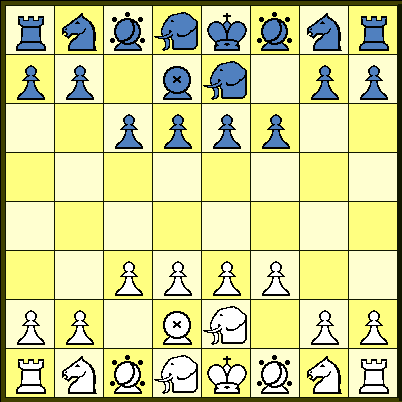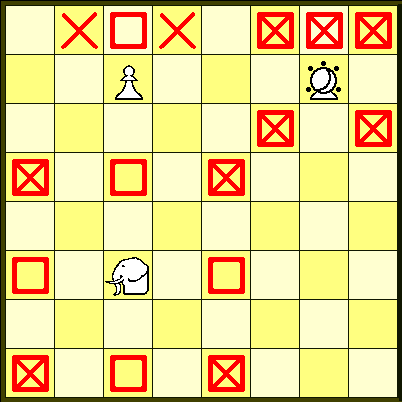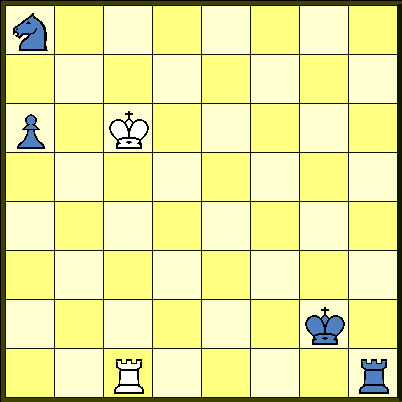Shatranj Kamil (64)by David Paulowich |

|
Introduction
This game was created for entry into the Chess Variant Pages 10th aniversary design contest. The name Shatranj Kamil, meaning Perfect Chess or Complete Chess, was given to several chess variants on 10x10 boards around 1000 years ago. Usually the variant would increase the size of each army by two pawns and two new pieces (for example, the dabbabah). Shatranj Kamil (64) is my attempt to achieve a similar result on the traditional 8x8 board. This game keeps all the pieces of Shatranj, while giving the elephants a more powerful move. Note that the "elephants on their own colors" setup of my game requires a checkered board for ease of play. The pawn structure is a compromise between Shatranj and Makruk (from Thailand), with only the pawns from the four central files starting on the third and sixth ranks. Each army has two additional pieces from Makruk, which I call Silver Generals (the Shogi name for the piece). All pawns promote on the player's eighth rank to Silver Generals - this is entirely different from the rules in Makruk and Shogi.
Setup and Pieces
 White:
White:
King e1; General d2; Elephant d1, e2; Silver General c1, f1; Knight b1, g1; Rook a1, h1; Pawn a2, b2, c3, d3, e3, f3, g2, h2.
Black:
King e8; General d7; Elephant d8, e7; Silver General c8, f8; Knight b8, g8; Rook a8, h8; Pawn a7, b7, c6, d6, e6, f6, g7, h7.
Initial Setup:
rnseksnr/pp1ge1pp/2pppp2/8/8/2PPPP2/PP1GE1PP/RNSEKSNR
Each army has 18 pieces with 18 possible moves in the initial setup. The eight Pawns, starting on the player's second and third ranks, can only move one square forward. The two Silver Generals have the same single-square movement as in Shogi: any of the four diagonal directions or directly forward. Each army has one King and one General. The General steps one space diagonally, a piece traditionally called a Ferz. Elephants may leap exactly two squares diatonally, like an Alfil, or when not capturing, may leap exactly two squares orthogonally like a Dabbabah. This results in a weaker version of the Alibaba, able to visit 16 of the squares of the board. Thus the two White Elephants control the 32 light squares between them, while the White General controls the 32 dark squares. The Black Elephants are on dark squares, while the Black General is on a light square. Knights and Rooks start on the usual squares and move in the usual way. The shortest possible game is: 1.Na3 e5 2.Nc4 d5 3.Nd6 mate.
Pawn=3, Elephant=5, General=5, Silver General=8.5, Knight=9, Rook=15 is my best guess for the values of the pieces. Elephants and Generals should be equal in value, which is one reason this game was designed to encourage players to trade one piece for the other. Silver Generals are almost as valuable as Knights. I simply gave the Silver General the average value of a General (5) and a Commoner (12), where the Commoner is the piece that can, like a King, move to any adjacent square. Do not attach too much significance to these (somewhat arbitrary) numbers.
The diagram below illustrates the moves of three pieces. Pawns always move forward. They capture (X symbol) diagonally and make a noncapturing move (hollow square symbol) orthogonally. Silver Generals move and capture in the same way (X inside hollow square symbol). There are ten pieces in each army (Pawns and Silver Generals) that are assymetric: they have an orthogonal forward move and no matching backward move. The unlimited promotion rule in this game means that it is possible to have ten Silver Generals of the same color on the board. There are ten pieces in each army (Pawns and Elephants) whose orthogonal moves must be noncapturing.

Rules
No king's leap or castling rules in this game. Pawns never move more than one square. I tried to remain true to the spirit of the old Shatranj rules, but found it necessary to modify Rule 4 and Rule 5 (below) to deal with some annoying special cases.[Rule 1] Mandatory promotion of a Pawn to a Silver General of the same color on the player's 8th rank.
[Rule 2] After your opponent has been reduced to a lone King, you may claim a draw at any time. The game is automatically drawn when only the two Kings remain on the board.
[Rule 3] Checkmating your opponent wins the game. Note that you require a king and at least one other piece in order to checkmate your opponent.
[Rule 4] Stalemating your opponent wins the game, except when you have only a lone King. Then the result is a draw. EXAMPLE: the endgame with a lone White King versus a Black King and a-file Pawn can end in several ways. White can stalemate Black, in a rather silly fashion, resulting in a draw by Rule 2. White can capture the pawn, resulting in an automatic draw by Rule 2. Black can stalemate White and win. Or Black can play on for another ten moves, until Rule 5 gives him a win.
[Rule 5] Bare King Loss: You are allowed to make ten moves after being reduced to a lone King in an attempt to achieve a draw under Rule 2 or Rule 4. The ten move count resets to zero after each capture. Your opponent may claim a win after your tenth move. EXAMPLE: the endgame in the diagram below shows White to move and draw. After 1.Rxh1 Kxh1 2.Kb7 a5 3.Kxa8 a4, the Black Pawn will promote to a Silver General on a1, but White can chase and quickly capture this piece.

Notes
The pattern of 28 empty squares is original to this chess variant. Peter Aronson's Gothic Isles Chess (2001) is an earlier game which allows pawns to promote to a variety of pieces, including Silver Generals. He provides some interesting comments on the history of chess, as well as a "Zillions of Games" file that correctly implements his game's bare king loss rule (same as Shatranj). I have not seen any other "Zillions of Games" author succeed in doing this - see my previously posted comments on the Shatranj rules page. Unfortunately, additional coding is required to implement my more complicated Rule 5. I would like to propose something similar to Rule 4 and Rule 5 for Chu Shogi and some other old Japanese games. I believe that I am in agreement with Colin Adams, who wrote in 1999:
If one player is reduced to a bare King (no other pieces), then he loses the game, unless he can immediately reduce his opponent to a bare King also (I would suggest that demonstrating that he can reduce his opponent to a bare King by a forced series of moves should also be allowed ...
Computer Play
Play Online: Shatranj Kamil (64) can be played on this site with Game Courier. Fully automated, rule-enforcing presets for this game can be found here. You can also view games that have previously been played on Game Courier here.
ChessV: Shatranj Kamil (64) is fully supported by ChessV, a free open-source program for playing chess variants.
Interactive Diagram: You can also play against a very basic AI with this interactive diagram
(click on "Play it!" under the diagram):
Equipment
Chess variant pieces are available from House of Staunton.
Daniel C. Macdonald's Omega Chess provides 44 pieces for players to use. The bishops can be used for elephants, the wizards for generals, and the champions for silver generals. Peter Aronson even calls his silver general piece a "champion" in Gothic Isles Chess. The best justification I can give for this choice is: the champion in Omega Chess is a short-range piece that can visits all the squares on the board. Thus it serves the same purpose in that game as the silver general does in Shatranj Kamil (64). For more information on Omega Chess go to www.omegachess.com. Temporarily out-of-stock.
Written by David Paulowich.
WWW page created: May 7, 2005.
WWW page updated: July 12, 2020 by Greg Strong.
